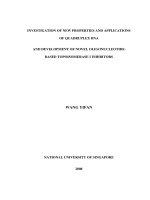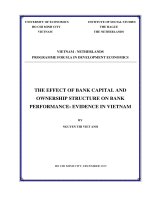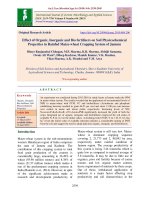Restoration ability of new inbred and restorer lines on different CMS sources in sunflower (Helianthus annuus L.)
Bạn đang xem bản rút gọn của tài liệu. Xem và tải ngay bản đầy đủ của tài liệu tại đây (102.66 KB, 5 trang )
Int.J.Curr.Microbiol.App.Sci (2019) 8(2): 2389-2393
International Journal of Current Microbiology and Applied Sciences
ISSN: 2319-7706 Volume 8 Number 02 (2019)
Journal homepage:
Original Research Article
/>
Restoration Ability of New Inbred and Restorer Lines on Different CMS
Sources in Sunflower (Helianthus annuus L.)
Sukanya Biradar*, A.G. Vijaykumar, G.K. Naidu, S.M. Vastrad and Shobha Immadi
Department of Genetics and Plant Breeding, College of Agriculture, Vijayapura
University of Agricultural Sciences, Dharwad-580005, Karnataka, India
*Corresponding author:
ABSTRACT
Keywords
CMS source,
Maintainer,
Restorer,
Helianthus
petiolaris sp. fallax,
H. annuus sp.
Lenticularis
Article Info
Accepted:
18 January 2019
Available Online:
10 February 2019
The development of commercial sunflower hybrids based on new CMS sources is of
special interest for reducing the potential risk of vulnerability to biotic stresses and for
increasing genetic diversity. Four CMS lines of sunflower (Helianthus annuus L.) viz.,
FMS 852A (Helianthus petiolaris sp. fallax), IMS 852A (H. annuus sp. lenticularis) and
CMS 302A and CMS 234A (H. petiolaris) were crossed with 40 inbreds to identify
fertility restorer lines for each CMS source. Only a few inbreds could restore fertility on
new CMS sources. Out of 25 new inbreds tested, 10 were found to be restorers for CMS
PET1. Only two inbreds (RHA-1-1 and IB-60) could restore fertility on CMS PEF, 8
behaved as partial restorers and the remaining 15 inbreds behaved as maintainers.
Similarly two inbreds (RHA-1-1 and NS-15) restored fertility on CMS I. Only one inbred
line RHA-1-1 could restore fertility on all the three CMS sources. A few effective restorers
were identified for the new CMS sources, which can be exploited in developing hybrids
with better heterotic potential.
Introduction
Sunflower being a highly cross pollinated
crop is ideally suited for exploitation of
heterosis. The discovery of Cytoplasmic Male
Sterility by Leclercq (1969) from Helianthus
petiolaris (PET 1) and fertility restoration by
Kinman (1970) provided the required
breakthrough in the commercial development
of sunflower hybrids. Moreover, hybrids are
highly self fertile and resistant to diseases,
thus resulting in enhanced seed set and seed
filling (Seetharam, 1981). The hybrids are
being cultivated on 80-90 per cent area in
India due to their high yield potential,
suitability to input intensive agriculture and
due to the role played by the private
companies. All the sunflower hybrids that are
commercially grown have a single source
(PET-1) leading to homogeneity and potential
risk of becoming susceptible to pest and
disease due to the continuous use of PET
source. From 1972 until now sunflower
hybrid program has relied entirely on single
2389
Int.J.Curr.Microbiol.App.Sci (2019) 8(2): 2389-2393
CMS source viz., PET cytoplasm, exposing it
to potential risk of pathogen or insects and
restricting the variability of genes inherited. It
is evident in case of maize, where, texas
(CMS-T) cytoplasm became susceptible to
Helminthosporium maydis as well as
pearlmillet due to its susceptibility to ergot
disease. In order to reduce the probable
chances of occurrence of similar problems
diversification of cytoplasmic male sterility in
sunflower is needed. In addition to the
continuing search for new cytoplasmic male
sterility sources, identification and use of new
restorer lines is quite essential to know the
fertility restoration on new CMS sources and
also to diversify the genetic base of the
hybrids for increased hybrid vigour,
adaptation and resistance to pest and diseases.
Hence, diversification of CMS sources is
inevitable in heterosis breeding which will
add flexibility and nuclear diversity to
breeding programmes. More than 40 CMS
sources have been described by Serieys
(1996), but lack of appropriate maintainers or
restorer lines as well as environmental
instability limits their agronomic ability. The
newly developed CMS sources for broadening
of genetic base of cytoplasm have revealed
polymorphisms in the mitochondrial DNA
(Crouzillat et al., 1994). But using these
diverse CMS sources, hybrids could not be
developed because of the non-availability of
effective restorers. In view of the limitation,
an attempt was made to identify restorers for
the newly developed CMS sources.
Materials and Methods
Three diverse CMS sources (lines) viz., FMS
852A from Helianthus petiolaris sp. fallax
(CMS PEF), IMS 852A from H. annuus sp.
lenticularis (CMS I) and CMS-234A and
CMS-302A from H. petiolaris (CMS PET)
and 25 new inbred and restorer lines of
diverse genetic background were obtained
from Directorate of Oilseeds Research
(DOR), Hyderabad. The 25 male parents and
three CMS sources (4 CMS lines) were sown
in the field to effect crossing in separate
blocks during summer 2015-16 with a spacing
of 60 x 30 cm staggered sowings of male
parents, twice at weekly interval, was done to
synchronize the flowering and recommended
agronomic practices were followed.
Before flower initiation, heads of the CMS
lines and restorers were bagged with a cloth
bag a day prior to anthesis in order to avoid
natural crossing. At anthesis, the pollen from
already bagged male parents collected in
different Petri-plates separately with the help
of a camel hair brush during morning hours
(9:00 am to 11:00 am). The three different
CMS sources were crossed to all the 25
inbreds in a line x tester method. The
pollinations were repeated 3-4 times on
alternate days to pollinate all the floret whirls
proceeding inwards. Hands and all crossing
equipments were sterilized with absolute
alcohol before pollination to reduce any
chance of contamination. The capitulae of
each of the CMS lines were pollinated with
known pollen parents and then covered with
cloth bags to avoid cross contamination and
individual plants were labeled mentioning
specific cross combination. The heads of all
the resultant 100 hybrids were harvested,
dried and threshed separately. The well filled
seeds from each cross were separated out for
hybrid evaluation.
The identification of behavior of new inbred
and restorer lines with respect to maintenance
and restoration of the CMS sources of
sunflower was done during kharif 2016 at
RARS, Vijayapura. F1 seeds from the 100
crosses were planted with two replications
and the plot size for each entry consisted of
two rows (0.6 meter) in each replication with
a spacing of 60 cm x 30 cm. At anthesis stage,
plants were classified as male fertile/male
sterile based on anther dehiscence and pollen
2390
Int.J.Curr.Microbiol.App.Sci (2019) 8(2): 2389-2393
shedding and the number of plants with or
without pollen shedding in each treatment
was recorded to work out per cent fertility.
Based on these observations, the crosses were
grouped as either sterile or fertile. The pollen
parent leading to sterile crosses were
classified as maintainers, while those parents
leading to fertile crosses were grouped as
restorers of the corresponding CMS lines.
Results and Discussion
The maintainer/restorer reaction of the
inbreds for different CMS sources has been
presented in table 1. Results indicated that out
of 25 test inbreds, 10 were found to be
restorers for the traditional PET-1 cytoplasm
CMS 234A, 12 behaved as partial restorers,
while remaining behaved as maintainers.
However, out of 25 inbreds, 10 were found to
be restorers for CMS-302A, 7 showed partial
fertility restoration and remaining 8 behaved
as maintainers.
Two inbreds viz., RHA-1-1 and IB-60 acted
as restorers for CMS PEF (FMS 852A)
cytoplasm, 8 inbreds behaved as partial
restorers and 15 inbreds behaved as
maintainers. For CMS I (IMS 852A)
cytoplasm, 2 inbreds i.e., RHA-1-1 and NS15 were found to be restorers whereas 8
inbreds showed segregation and the remaining
15 behaved as maintainers. Such inbred lines
that turned out as maintainers for FMS 852A
were also behaving as maintainers on IMS
852A background. Only two inbred lines
namely RHA-1-1 and IB-60 on FMS 852A
and RHA-1-1 and NS-15 on IMS 852A acted
as complete restorers. This indicates that the
genetic constitution and interaction of FMS
852A and IMS 852A are different from that
of the PET source and necessitates
identification of restorer lines having R genes
for fertility restoration. Similar results of
differences in fertility restoring genes for
different CMS backgrounds have been
reported by Reddy et al., (2008) and Dudhe et
al., (2009).
Only one elite inbred RHA-1-1 restored
fertility in all the four CMS lines and acted as
common restorer, this indicated that though
CMS lines were different by cytoplasmic
background, the fertility restoring gene could
be same. While 15 inbreds acted as common
maintainers for two new CMS sources,
suggesting the absence of fertility restoration
genes in these inbreds. Kukosh (1981)
reported that inbreds were found to carry Rf
genes and can restore fertility with CMS lines
developed
with
diverse
cytoplasmic
background. The inbred lines restoring
fertility to different forms of CMS sources
were found to be most useful in practical
breeding programmes.
Ten inbreds viz., GP-5, GP-9, NS-15, DSR107, DSR-35, IB-03, DSR-37 and IB-104
acted as partial restorer for CMS PEF
cytoplasm and behaved as restorers for PET-1
cytoplasm.
It is evident from present
investigation that few inbreds behaved
differently with the three cytoplasmic
backgrounds in respect of maintainer and
restorer behaviour suggesting the presence of
modifying genes influencing the fertility
restoration, resulting in partial fertility
(Rukmini Devi et al., 2006; Dudhe et al.,
2009). The inbred lines viz., GP-5, GP-9,
DSR-107, DSR-35, IB-60, IB-03, DSR-37
and IB-104 behaved as partial restorer on
CMS I cytoplasm, acted as fertility restorer
for PET-1 cytoplasm. Higher number of
maintainers was identified compared to
restorers offering the more scope for CMS
conversion programme and few restorers
identified for new CMS sources suggested
that new CMS sources could be used for CMS
diversification as well as development of
potential hybrids. Similar results were
obtained in the study of Sujatha and Reddy et
al., (2008).
2391
Int.J.Curr.Microbiol.App.Sci (2019) 8(2): 2389-2393
Table.1 Maintainer/restorer reaction of different inbred and restorer lines in the background of
four CMS lines (three sources)
Inbreds
RHA-1-1
GP-9
GP-5
5 RI
IB-03
DSR-107
DSR-35
IB-60
DSR-37
NS-15
DSR-133
IB-51
NR P1
IB-104
ID-2089
14R
NS-8
GP6-1418
DSRI-411
B4 L-21
B2 L-13
B5 L-16
B4 L-6
B4 L-18
NS-3
PET 1
CMS 302A
R
R
R
M
R
R
R
R
R
R
M
S
M
R
S
M
S
S
S
M
S
M
M
M
S
CMS 234A
R
R
R
S
R
R
R
R
R
R
S
S
S
R
S
S
S
S
S
M
S
S
M
S
S
The restorers identified for new CMS sources
will help in their exploitation for hybrid
development with better heterosis and
diversity of cytoplasm in sunflower. The new
CMS lines can be safely included in the
breeding programme to broaden the genetic
base of cytoplasmic male sterility in
sunflower to avoid the possible risk of
susceptibility. The identified maintainers after
testing for their combining ability will be
converted into new cytoplasmic male sterile
lines and may be used in sunflower breeding
programmes for developing diverse hybrids
CMS PEF
FMS 852A
R
R
R
M
R
S
S
R
S
R
M
M
M
R
M
M
M
M
M
M
M
M
M
M
M
CMS I
IMS 852A
R
R
R
M
R
S
S
R
S
R
M
M
M
R
M
M
M
M
M
M
M
M
M
M
M
with better heterosis and resistance to disease
and insect pests.
Acknowledgement
The authors are thankful to the Directorate of
Oilseeds Research, Hyderabad, India, for
providing the germplasm.
References
Chandra, S. B., Sudheer Kumar, S. and Dudhe, M.
Y., 2010, Inheritance of fertility restoration
for different CMS sources in Sunflower
2392
Int.J.Curr.Microbiol.App.Sci (2019) 8(2): 2389-2393
(Helianthus annuus L.). J. Breeding and
Genetics., 42(1) : 46-50.
Channamma, B. K., 2009, Fertility restoration,
Heterosis and Combining ability involving
diverse CMS sources in sunflower
(Helianthus annuus L.). M. Sc. (Agri.) Thesis,
Univ. Agric. Sci., Dharwad (India).
Dudhe, M., Satish Chandra, B. and Sudheer
Kumar, S., 2010, Identification of restorers for
diverse CMS sources in sunflower
(Helianthus annuus L.). J. Oilseed Res., 28(1):
71-73.
Gourishankar, V., Ganesh, M., Ranganath, A. R.
G., Reddy, D. L. and Suman, A., 2006,
Performance of elite inbreds with diverse
CMS sources in sunflower (Helianthus
annuus L.). Agric. Sci. Digest. 26(4): 291293.
Kinman, M. L., 1970, New development in the
USDA and State Experiment Station,
Sunflower
breeding
programme.
In:
Proceedings of the Fourth International
Sunflower Conference, Memphis, Tennessa,
pp. 181-183.
Kumar, T. G., Reddy, A. and Sudheer K. S., 2001,
Exploitation of heterosis using diverse source
of cytoplasm in sunflower. J. Oilseeds Res.,
18: 21-23.
Leclercq, P., 1971, La sterilite cytoplasmique du
tournesol-1. premieres etudes sur la
restoration de law fertile. Annales del
Amelioration des Plantes, 21: 45-54.
Leclercqe, P., 1969, Line sterile cytoplasmique
chezk tournesol. Ann. Amelior Planta, 12: 99106.
Meena, H. P. and Prabakaran, A. J., 2016,
Identification of fertility restorers and
maintainers in sunflower (Helianthus annuus
L.) for gene pool and exotic materials.
Electronic J. Plant Breeding, 7(3): 778-783.
Miller, J. F., 1996, Inheritance of restoration of
Helianthus petiolaris sp. fallax (PEF 1)
cytoplasmic male sterility. J. Oilseed Res.,
36(1): 83-86
Patil, S.A., Gafoor, A. and Ravi Kumar, R. L.,
2003, Impact of Cytoplasmic male sterile
sources on seed yield and yield components in
sunflower. Helia, 26(38): 67-72.
Pavani, E., Bharathi, M. and Reddy, A. V., 2007,
Maintainer and restorer behavior of some elite
inbred lines on different cytoplasmic male
sterility sources and inheritance of
fertilityrestoration in sunflower, (Helianthus
annuus L.). J. Oilseeds Res., 24(2): 248-250.
Reddy, A. V. V., Devasenamma, V. and Madhavi
Latha, K., 2002, Identification of restorers and
maintainers for different CMS sources in
sunflower (Helianthus annuus L.). J. Oilseeds
Res., 19(1): 11-12.
Reddy, C. V. C. M., Reddy, A.V.V., Sinha, B. and
Reddy, Y. M., 2008, Maintenance of Male
Sterility and Fertility Restoration in Different
CMS Sources of Sunflower (Helianthus
annuus L.). Asian J. Pl. Sci., 7 (8): 762-766.
Rukminidevi, K., Ganesh, M. and Ranganadha, A.
R.G., 2006, Inheritance of fertility restorers
for new CMS sources in sunflower
(Helianthus annuus L.). J. Oilseeds Res.,
23(1): 46-48.
Serieys, H., 1996, Study and utilization in
breeding programs of new CMS sources. FAO
Research Network on Sunflower Report, 1-13.
Sujatha, M. and Vishnuvardhan Reddy, A., 2008,
Identification of fertility restorers/ maintainers
in sunflower (Helianthus annuus L.). J.
Oilseeds Res., 25(2): 181-182.
Venkanna, V., Reddy, D. and Ranganatha, A.
R.G., 2008, Identification of restorers and
maintainers for different CMS sources in
sunflower using new inbreds. Helia, 31 (49):
65-70.
Virupakshappa, K., Seetharam, A. and Ravi
Kumar, R. L., 1991, Maintainer and restorer
behavior of some sunflower lines of new
cytoplasmic male sterile sources. J. Oilseeds
Res., 8: 195-198.
How to cite this article:
Sukanya Biradar, A.G. Vijaykumar, G.K. Naidu, S.M. Vastrad and Shobha Immadi. 2019.
Restoration Ability of New Inbred and Restorer Lines on Different CMS Sources in Sunflower
(Helianthus annuus L.). Int.J.Curr.Microbiol.App.Sci. 8(02): 2389-2393.
doi: />
2393









